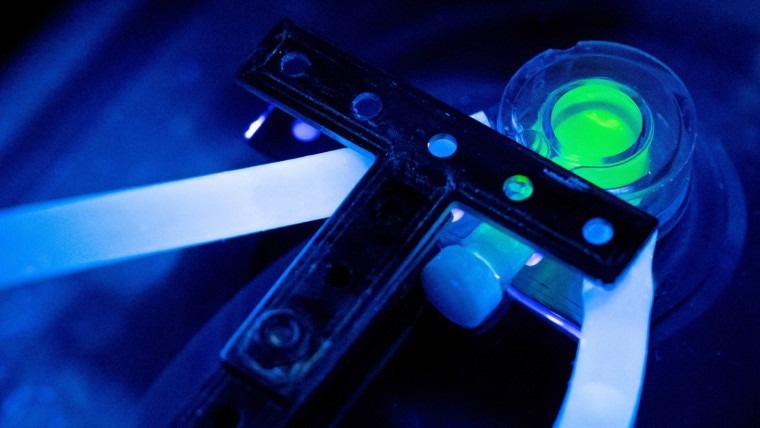External mechanical stress causes mechanoluminescent materials to generate visible or invisible light. Excitation can be induced by bending or moderate pressure, but it can also be completely achieved without contact using ultrasound.
 Mechanoluminescent material during an experiment. Image Credit: Jens Meyer (University of Jena)
Mechanoluminescent material during an experiment. Image Credit: Jens Meyer (University of Jena)
The effect can be initiated remotely in this fashion, and light can be transported to ordinarily dark locations, such as the human body. If the ultrasonic therapy is used to create local heat at the same time, it is critical to monitor the temperatures that occur in such a delicate setting.
Material scientists from the Friedrich Schiller University in Jena, Germany, have discovered a mechanoluminescent material that can be used to generate local heat input by ultrasound while simultaneously providing feedback on the local temperature. They published their findings in the scientific journal Advanced Science.
Semiconductors and Rare Earths
The Jena scientists frequently engage with the mechanical characteristics of inorganic materials in their research, especially on how mechanical processes can be observed optically.
Mechanically induced light emission can provide us with many details about a material’s response to mechanical stress. But in order to expand the field of applications, it is sometimes also necessary to obtain additional information about the local temperature—especially when the excitation is carried out by means of ultrasound.
Lothar Wondraczek, Professor, University of Jena
Wondraczek added, “Here, we were initially interested in sensor materials in the form of ultra-fine particles, which—introduced into the environment to be studied—can provide feedback information about how ultrasound interacts with this environment.”
The Jena researchers achieved this by combining an oxysulfide semiconductor with erbium oxide, a rare earth element. The erbium oxide emits light after the semiconducting structure absorbs mechanical energy delivered by ultrasonic stimulation. Optical thermometry can then be used to read the temperature from the spectrum of the produced light.
“This means that we can stimulate a temperature increase from the outside, measure it from the characteristics of light emission, and thus establish a complete control circuit,” explained Wondraczek.
Application in Photodynamic Therapy
Remote-operated light emission in combination with temperature control might open up entirely new applications for mechanoluminescent materials, such as in medicine.
“One possible field of application could be photodynamic therapy, in which light is used to control photophysical processes that can support the organism in healing,” stated Wondraczek.
Not only could light and heat be created in the desired area but they could also be controlled in a targeted manner using multi-responsive mechanoluminescent materials in the form of very small particles. Since biological tissue is permeable to infrared light, the desired temperature can be established and controlled from the outside during therapy.
Wondraczek added, “However, such ideas are still very much in their infancy. Very extensive research and study are still needed in order to put them into practice.”
Other applications in which light and heat must be provided to dark regions in a targeted manner are more accessible. Photosynthesis and other light-driven processes, for example, could be precisely started, detected, and controlled.
Similarly, the material can be utilized as a sensor for creating or detecting material changes, as well as an invisible, coded marker on material surfaces.
Journal Reference:
Ding, Y., et al. (2022) Ultrasound-Induced Mechanoluminescence and Optical Thermometry Toward Stimulus-Responsive Materials with Simultaneous Trigger Response and Read-Out Functions. Advanced Science. doi:10.1002/advs.202201631